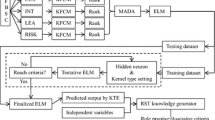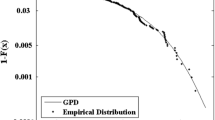Abstract
The deterioration in enterprises’ profitability not only threatens the interests of those firms, but also means related parties (investors, bankers, and stakeholders) could encounter tremendous financial losses, which could also impact the circulation of limited economic resources. Thus, an enterprise risk forecasting mechanism is urgently needed to assist decision-makers in adjusting their operating strategies so as to survive under any highly turbulent economic climate. This research introduces a novel hybrid model that incorporates an incremental filter-wrapper feature subset selection with the statistical examination and twin support vector machine (IFWTSVM) for enterprise operating performance forecasting. To promote a hybrid model’s real-life application, the knowledge visualization extracted from IFWTSVM is represented in an easy-to-grasp style. The experimental results reveal that IFWTSVM’s forecasting quality is very promising for financial risk mining, relative to other forecasting techniques examined in this study.

Similar content being viewed by others
References
Abbasi A, Altmann J, Hossain L (2011) Identifying the effects of co-authorship networks on the performance of scholars: a correlation and regression analysis of performance measures and social network analysis measures. J Informetr 5:594–607
Altman EI (1968) Financial ratios, discriminant analysis and the prediction of corporate bankruptcy. J Financ 23:589–609
Ashfaq RAR, Wang XZ, Huang JZX, Abbas H, He YL (2016) Fuzziness based semi-supervised learning approach for intrusion detection system (IDS). Inform Sci. doi:10.1016/j.ins.2016.04.019
Avkiran NK (2015) An illustration of dynamic network DEA in commercial banking including robustness tests. Omega 55:141–150
Bai L, Wang Z, Shao YH, Deng NY (2014) A novel feature selection method for twin support vector machine. Knowl-Based Syst 59:1–8
Bermejo P, Gámez JA, Puerta JM (2011) A GRASP algorithm for fast hybrid (filter-wrapper) feature subset selection in high-dimensional datasets. Pattern Recognit Lett 32:701–711
Bermejo P, Ossa L, Gámez JA, Puerta JM (2012) Fast wrapper feature subset selection in high-dimensional datasets by means of filter re-ranking. Knowl-Based Syst 25:35–44
Boj JJ, Rodriguez-Rodriguez R, Alfaro-Saiz JJ (2014) An ANP-multi-criteria-based methodology to link intangible assets and organizational performance in a balanced scorecard context. Decis Support Syst 68:98–110
Bray S, Caggiani L, Ottomanelli M (2015) Measuring transport systems efficiency under uncertainty by fuzzy sets theory based data envelopment analysis: theoretical and practical comparison with traditional DEA model. Transp Res Proced 5:186–200
Charnes A, Cooper W, Rhodes E (1978) Measuring the efficiency of decision-making units. Eur J Oper Res 2:429–444
Chen WJ, Shao YH, Hong N (2014) Laplacian smooth twin support vector machine for semi-supervised classification. Int J Mach Learn Cybern 5:459–468
Chen M, Ludwig SA (2014) Particle swarm optimization based fuzzy clustering approach to identify optimal number of clusters. J Artif Intell Soft Comput Res 4:43–56
Dagher J, Kazimov K (2015) Banks' liability structure and mortgage lending during the financial crisis. J Financ Econ 116:565–582
Dimitras AI, Zanakis SH, Zopounidis C (1996) A survey of business failures with an emphasis on prediction methods and industrial applications. Eur J Oper Res 90:487–513
Fancello G, Uccheddu B, Fadda P (2014) Data envelopment analysis (D.E.A.) for urban road system performance assessment. Proced—Soc Behav Sci 111:780–789
Freeman L (1979) Centrality in social networks: conceptual clarification. Soc Netw 1:215–239
Gan Q, Hasan BAS, Tsui CS (2014) A filter-dominating hybrid sequential forward floating search method for feature subset selection in high-dimensional space. Int J Mach Learn Cybern 5:413–423
Guthrie J, Ricceri F, Dumay J (2012) Reflections and projections: a decade of intellectual capital accounting research. Br Acc Rev 44:68–82
Guimarães VA, Leal Junior IC, Almada Garcia PA (2014) Environmental performance of Brazilian container terminals: a data envelopment analysis approach. Proced—Soc Behav Sci 160:178–187
Geng R, Bose I, Chen X (2015) Prediction of financial distress: an empirical study of listed Chinese companies using data mining. Eur J Oper Res 241:236–247
Gnyawali DR, Madhavan R (2001) Cooperative networks and competitive dynamics: a structural embeddedness perspective. Acad Manage Rev 26:431–445
He YL, Wang XZ, Huang JZX (2016) Fuzzy nonlinear regression analysis using a random weight network. Inform Sci. doi:10.1016/j.ins.2016.01.037
Huber C, Scheytt T (2013) The dispositif of risk management: reconstructing risk management after the financial crisis. Manage Acc Res 24:88–99
Jayadeva, Khemchandani R, Chandra S (2007) Twin support vector machines for pattern classification. IEEE Trans Pattern Anal Mach Intell 29:905–910
Kennedy J, Eberhart R (1995) Particle swarm optimization. In: Proceedings of the fourth IEEE international conference on neural networks, Perth, Australia. IEEE Service Center 1942–1948
Kim DY (2014) Understanding supplier structural embeddedness: a social network perspective. J Oper Manage 32:219–231
Kim KJ (2003) Financial time series forecasting using support vector machines. Neurocomputing 55:307–319
Kim HS, Sohn SY (2010) Support vector machines for default prediction of SMEs based on technology credit. Eur J Oper Res 201:838–846
Kumar MA, Gopal M (2010) Fast multiclass SVM classification using decision tree based one-against-all method. Neural Process Lett 32:311–323
Kou G, Peng Y, Wang G (2014) Evaluation of clustering algorithms for financial risk analysis using MCDM methods. Inform Sci 275:1–12
Lin SJ, Hsu MF (2016) Incorporated risk-adjusted balanced scorecards and hybrid AI techniques for risk management. Neural Comput Appl. doi:10.1007/s00521-016-2253-4
Lin SJ (2016) Hybrid kernelized fuzzy clustering and multiple attributes decision analysis for corporate risk management. Int J Fuzzy Syst. doi:10.1007/s40815-016-0196-7
Lin SJ, Chen TF (2016) Multi-agent architecture for corporate operating performance assessment. Neural Process Lett 43:115–132
Lu SX, Wang XZ, Zhang GQ, Zhou X (2015) Effective algorithms of the Moore-Penrose inverse matrices for extreme learning machine. Intell Data Anal 19:743–760
Oliveira L, Rodrigues LL, Craig R (2010) Intangible assets and value relevance: evidence from the Portuguese stock exchange. Br Acc Rev 42:241–252
Prado RP, Galan SG, Exposito JE, Yuste AJ (2010) Knowledge acquisition in fuzzy-rule-based systems with particle-swarm optimization. IEEE T Fuzzy Syst 18:1083–1097
Peng Y, Wang G, Kou G, Shi Y (2011) An empirical study of classification algorithm evaluation for financial risk prediction. Appl Soft Comput 11:2906–2915
Peng Y, Wang G, Wang H (2012) User preferences based software defect detection algorithms selection using MCDM. Inf Sci 191:3–13
Qiao P, Ju X, Fung HG (2014) Industry association networks, innovations, and firm performance in Chinese small and medium-sized enterprises. China Econ Rev 29:213–228
Ruiz R, Riquelme JC, Aguilar-Ruiz JS (2006) Incremental wrapper-based gene selection from microarray data for cancer classification. Pattern Recognit 39:2383–2392
Shao YH, Chun CH, Wang XB, Deng NY (2011) Improvements on twin support vector machines. IEEE T Neural Netw 22:962–968
Shao YH, Chen WJ, Zhang J, Wang Z, Deng NY (2014) An efficient weighted Lagrangian twin support vector machine for imbalanced data classification. Pattern Recognit 47:3158–3167
Striukova L, Unerman J, Guthrie J (2008) Corporate reporting of intellectual capital: evidence from UK companies. Br Acc Rev 40:297–313
Sueyoshi T, Wang D (2014) Sustainability development for supply chain management in US petroleum industry by DEA environmental assessment. Energy Econ 46:360–374
Sun J, Li H (2008) Data mining method for listed companies’ financial distress prediction. Knowl-Based Syst 21:1–5
Sun J, He KY, Li H (2011) SFFS-PC-NN optimized by genetic algorithm for dynamic prediction of financial distress with longitudinal data streams. Knowl-Based Syst 24:1013–1023
Soman S, Jayadeva (2015) High performance EEG signal classification using classifiability and the Twin SVM. Appl Soft Comput 30:305–318
Tinoco MH, Wilson N (2013) Financial distress and bankruptcy prediction among listed companies using accounting, market and macroeconomic variables. Int Rev Financ Anal 30:394–419
Tsai CF, Lu YH, David Yen C (2012) Determinants of intangible assets value: the data mining approach. Knowl-Based Syst 31:67–77
Tsai W (2000) Social capital, strategic relatedness and the formation of intraorganizational linkages. Strat Manage J 21:925–939
Tsai W (2001) Knowledge transfer in intraorganizational networks: effects of network position and absorptive capacity on business unit innovation and performance. Acad Manage J 44:996–1004
Tomar D, Agarwal S (2015) Twin support vector machine: a review from 2007 to 2014. Egypt Inform J 16:55–69
Vapnik V (1995) The nature of statistical learning theory. Springer, New York
Wang XY, Yang HY, Zhang Y, Fu ZK (2013) Image denoising using SVM classification in nonsubsampled contourlet transform domain. Inf Sci 246:155–176
Wang XZ, Ashfaq RAR, Fu AM (2015) Fuzziness based sample categorization for classifier performance improvement. J Intell Fuzzy Syst 29:1185–1196
Wang XZ (2015) Uncertainty in learning from big data-editorial. J Intell Fuzzy Syst 28:2329–2330
Xiang J, Han XH, Duan F, Qiang Y, Xiong XY, Lan Y, Chai H (2015) A novel hybrid system for feature selection based on an improved gravitational search algorithm and k-NN method. Appl Soft Comput 31:293–307
Xu X, Wang Y (2009) Financial failure prediction using efficiency as a predictor. Expert Syst Appl 36:366–373
Yang CH, Motohashi K, Chen JR (2009) Are new technology-based firms located on science parks really more innovative?: evidence from Taiwan. Res Policy 38:77–85
Author information
Authors and Affiliations
Corresponding author
Rights and permissions
About this article
Cite this article
Chang, TM., Hsu, MF. Integration of incremental filter-wrapper selection strategy with artificial intelligence for enterprise risk management. Int. J. Mach. Learn. & Cyber. 9, 477–489 (2018). https://doi.org/10.1007/s13042-016-0545-8
Received:
Accepted:
Published:
Issue Date:
DOI: https://doi.org/10.1007/s13042-016-0545-8




